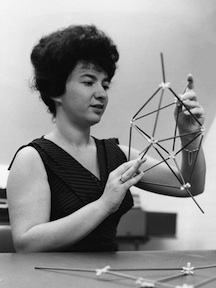By Krysta M. Larson
In August, renowned research scientist Joyce Jacobson Kaufman (ΦBK, Johns Hopkins, 1960) passed away at age 87. She was a distinguished scientist in numerous fields, including physics, chemistry, biomedicine, pharmacology, and supercomputers. Though her accomplishments in these fields are numerous, she is best known for producing an innovative strategy for using computers to predict toxicology and drug reactions, and for her use of chemistry to calculate carcinogens. According to her daughter, Rabbi Jan Caryl Kaufman, Kaufman’s groundbreaking work in drug and cancer research has saved thousands of lives.
Throughout her career, Kaufman paved the way for women with her numerous achievements in education and in the sciences. According to family members, Kaufman discovered her passion for science at the age of eight after reading a biography of Marie Curie. She was admitted to Johns Hopkins University in 1945 as a special student; women would not be admitted to the university as regular students until 1970. Of the eight women who were allowed to pursue degrees in science and engineering, Kaufman was one of the two who graduated. Due to her designation as a special student, Kaufman did not gain membership to Phi Beta Kappa until she earned her PhD from Hopkins in 1960, although she was eligible as an undergraduate.
In 1952 she worked as a researcher in the physical chemistry lab of her former professor at Johns Hopkins, and received her master’s in chemistry in 1959. After receiving her PhD, she joined the Research Institute for Advanced Studies at the Martin Marietta Company in Baltimore as a scientist in the quantum chemistry research group. She stayed with the organization for nine years, eventually becoming the leader of her research group. During that time, she traveled to Paris for a year as a visiting scholar at the Centre de Mechanique Ondulatoire Appliquee at the Sorbonne. Kaufman received an honorary doctorate in theoretical physics from the Sorbonne in 1963 and was pronounced une dame chevalière of France in 1969.
In 1969 she returned to Johns Hopkins as a principal research scientist, where she remained until the end of her career in the late 90s. During her career, Kaufman published over 300 papers, co-founded the Journal of Computational Chemistry, was appointed in the Johns Hopkins School of Medicine as associate professor of anesthesiology and later of plastic surgery, and made numerous contributions to her various fields. She carried out the first all-valence-electron, three-dimensional quantum-chemical calculations, one of her most noteworthy accomplishments. Her investigations into the effects of tranquilizers and narcotic drugs through the use of computers resulted in an increased understanding of how drugs such as morphine affect the central nervous system.
Among the many awards that Kaufman received over her lifetime were the Garvan Medal of the American Chemical Society in 1974 (given to distinguished women in chemistry) and designation as a corresponding member of the Académie Européenne des Sciences, des Arts, et des Lettres in 1981. Kaufman was also named as one of ten outstanding women in Maryland in 1974 by the Jewish National Fund.
After Kaufman’s passing, her family received numerous letters from women and scientists who attributed her legacy and career as inspirations for their own aspirations in scientific fields. Kaufman’s groundbreaking achievements in her fields reflect her dedication to the pursuit of excellence in the sciences and paved the way for fellow female scientists to excel.
Krysta M. Larson is a senior at Creighton University double majoring in English and journalism. She is a recently inducted member of Phi Beta Kappa. Creighton is home to the Beta of Nebraska Chapter of Phi Beta Kappa.




